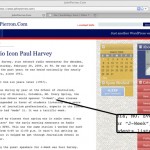Way back in the day, when someone said “system font” what came to mind was a mono spaced font used to display information of and relating to the system, hence “system” font.
The reason was obvious to us old-heads, before there were screen fonts for editing, there were punched cards. Each punched card had 80 columns, as did the screen — everyone was happy. Continuation to another card? Put an “X” in column 72. I can’t imagine what these kids today would do if they had to sit down at a keypunch and type in all their code. Wrong key? Whoops! Gotta get a new card … Hunting down bugs? Nowadays syntax highlighting makes errors hop off the screen …
Anyway, my torturous past has nothing to do with the real reason for this post, it has to do with “System Fonts” …
Do you think the system font has anything to do these days with the site design of the operating system manufacturer? I think it probably does. Now, a system font seems to be a font that came with the system. So, Verdana was a Microsoft system font, and Lucida Grande is a Mac system font. I say Verdana was because it seems to be readily available on all systems now, but initially it wasn’t and you will not find Lucida Grande on a MS Windows based machine. MS Windows Vista introduced Segoe UI as its font.
Being that these systems (companies) like to make their web sites in the default font of their operating system, things don’t look the same on all platforms. What I think is strange is that Microsoft totally changed their web site, so it’s back to the ol’ fonts, but how much more does Microsoft look like it wants to be Apple anymore? Frankly, it’s embarrassing … but that’s another topic that will only be mentioned in passing in this post.
This WordPress theme that I’m using while this post was made (don’t know if I will or won’t change it) is made to resemble a Mac type interface. In doing this, the Lucida Grande font is selected to be displayed to visitors. If, however, you’re not a Mac visitor, you’re not going to see the Lucida Grande font just as if you went to http://www.apple.com … So what is the fall back? I chose Tahoma for my MS Windows brethren … I will also look into putting in Segoe UI so that Vista peeps will have a better experience in their viewing pleasure.
So there you have it, a system font is no longer a mono-spaced font used for interfacing with the intricacies of an operating system and its code, it’s now all about style …

